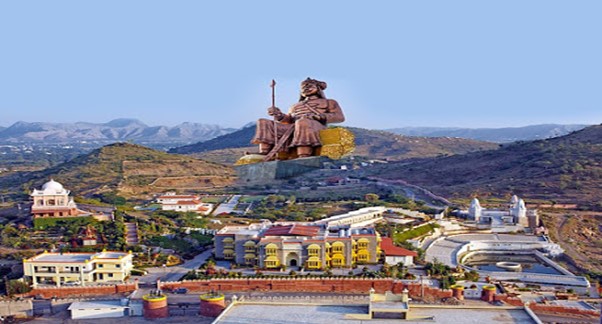UDAIPUR - Rajasthan Heritage
The city of Udaipur is a picturesque country surrounded by Azure Lake lakes that are dotted with lush
Aravails.
A white vision tied to love and
beauty, Udaipur is an attractive combination of visual sounds, and
experience-inspired thought for poets, artists, and writers. also known as
"Lake City", a city in the state of Rajasthan, India.
It is the historic capital of the
state of Mewar in the former Rajputana Agency. It was founded in 1558 by Udai
Singh II of the Rajodesian Rajput family while moving his capital from the city
of Chittorgarh to Udaipur after Chittorgarh was besieged by Akbar.
It remained the capital until
1818 when it became the British monarchy, after which the state of Mewar
became part of Rajasthan when India gained independence in 1947.
Buildings and palaces in Udaipur
Change image every 5 seconds:Slideshow
City Palace
City Palace passes Pichola Lake. Maharana
Udai Singh started the palace's construction, but successive Maharanas added
numerous palaces and structures to the structure, which still has a strong
similarity to the original.
The entrance to the Palace comes
from Hati Pol, at the Elephant Gate. Bari Pol or Great Gate brings you to
Tripolia, the third gate. It was customary for the Maharana to weigh under the
gate gold and silver, which was distributed to the people. It is now the main
ticket office.
Fateh Prakash Palace:
It is like a collection of real
royal luxury at Fateh Prakash Palace, the HRH's largest museum. The warmth of
royal hospitality greets you as you walk down the corridors full of the great
paintings of Mewar School which thrived in the seventeenth and nineteenth
centuries.
Lake Palace:
Lake Palace is situated on Jag
Niwas Island, which spans 1.5 hectares in the middle of Pichola Lake. It was
constructed as a summer palace by Maharana Jagat Singh in 1743 and is now a
five-star hotel.
It is a magical palace and its
image in the center of the lake resembles a straight leaf without a fairy tale
of intricate art and ethnic themes that use fabrics and handicrafts everywhere
highlighting the beauty beyond just comparing the surrounding lake making a
spectacular murmur with its extravagant waves and spectacular moments.
Monuments and Havelis in Udaipur
Bagore-Ki Haveli:
This is an old mansion built
directly on the shores of Lake Pichola in Gangori Ghat. Amir Chand Badwa, Prime
Minister of Mewar was built in the eighteenth century.
The palace has over 100 rooms and is home to some of the most fascinating exhibits of modern clothing and art. The glass and mirror inside the interior have a subtle work of Haveli and are well maintained.
Maharana Pratap Monument:
A terrified bronze statue of
Maharana Pratap and his beloved and loyal horse, which he vigorously defended
by his master and stood by him until his final death, stood on the top of Moti
Magri (Pearl Mount) facing Fateh Sagar.
The locals climbed the hill in the honor of Rana Pratap and his faithful charger 'Chetak', who was killed in the
battle of Haldighati.
There are remnants of one of
Udaipur's earliest forts are nearby, as well as a lovely Japanese stone garden.
JAG MANDIR
The Jag Mandir mansion is located on an island in Lake Pichola. Also known as the "Lake Garden Palace", it was built by three Maharanas of the kingdom of Mewar.
Construction began in 1551 and
was completed in 1652. The royal family used the palace as a summer residence
and a palace of joy.
Pratap Gaurav Kendra:
Pratap Gaurav Kendra Rashtriya Tirtha is located in Tiger Hill. It was founded by the Veer Shiromani Maharana Pratap Samiti with the goal of providing knowledge on Maharana Pratap and the area's historical heritage via the use of contemporary technologies.
Gulab Bagh & Zoo:
Gulab Bagh is the largest
territory in Udaipur, located in the heart of the city. It is well-known for a broad range of fields and attractions such as lakes, a library, a toy train, a
zoo, temples, and the Arya Samaj religious center, as well as several
government buildings.
Pratap Park:
Paratat Park is a field near the bank of Pichola Lake. It has an open gym and many other attractions. It found it attractive because of the alphabet-equivalent characters that read "I LOVE UDAIPUR", with a view of Lake Pichola and City Palace in the background.



























